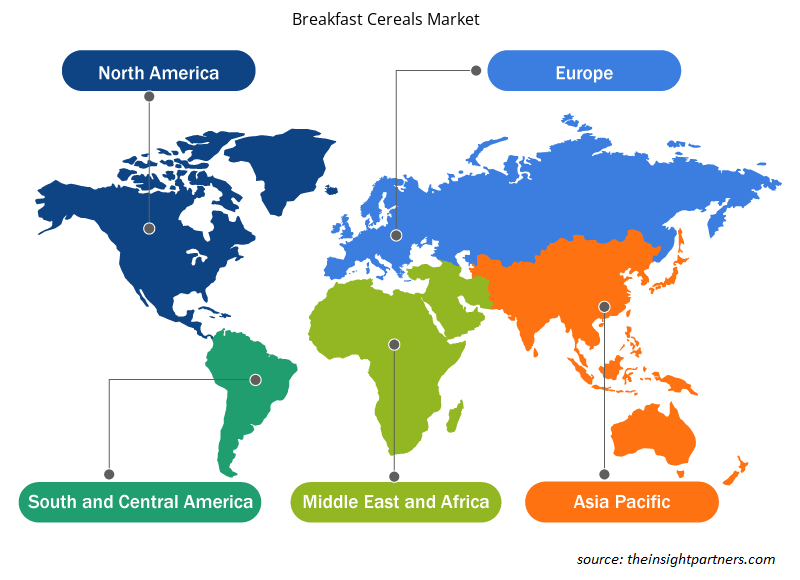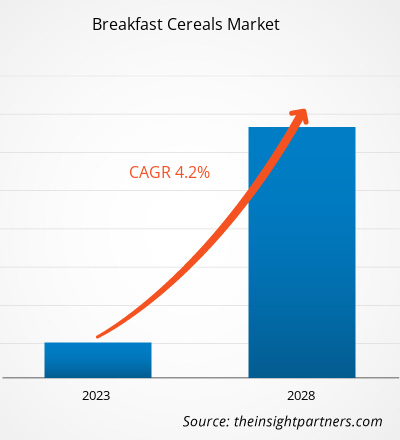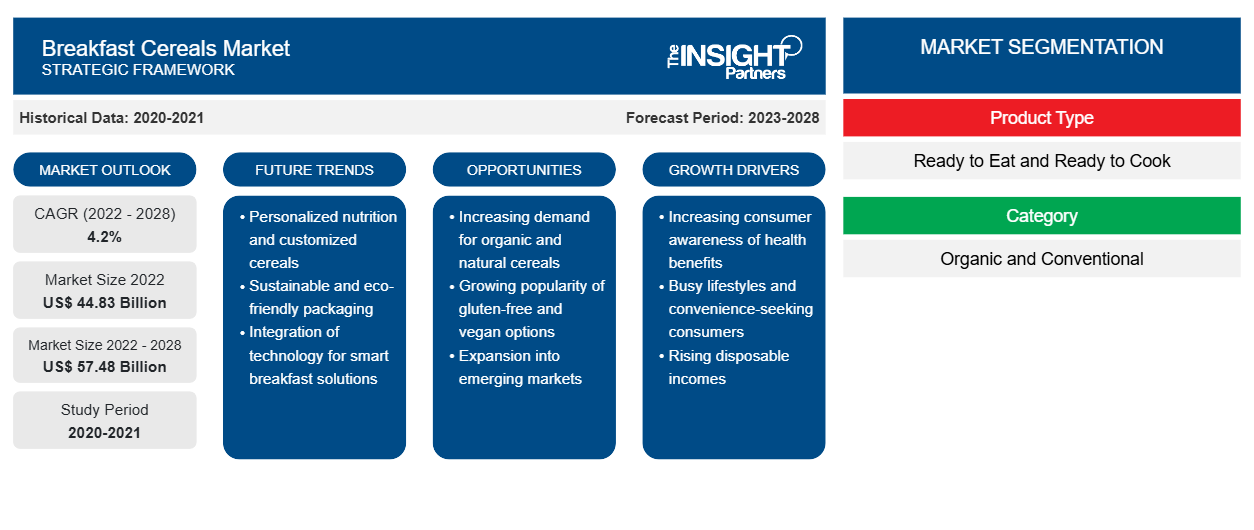Le marché des céréales pour petit-déjeuner devrait atteindre 57 482,17 millions USD d'ici 2028, contre 44 831,48 millions USD en 2022. Il devrait croître à un TCAC de 4,2 % au cours de la période 2022-2028.
La croissance du marché est attribuée à la préférence croissante des consommateurs pour les aliments prêts à consommer. De nos jours, les gens ont des modes de vie et des valeurs sociales différents, ce qui alimente la demande d'aliments prêts à consommer. La technologie numérique leur permettant de faire des achats plus rapidement a accru leur dépendance aux plats préparés. Ces produits sont disponibles sous différentes formes et variétés, telles que les plats à micro-ondes, les plats à emporter, les nouilles instantanées et d'autres types de plats, ce qui a augmenté la disponibilité des aliments au Royaume-Uni. L'augmentation de la consommation d'aliments prêts à consommer a conduit les consommateurs à acheter davantage de plats préparés dans la région. Cependant, en raison des confinements causés par l'épidémie de COVID-19, les consommateurs ont eu recours à la cuisine à la maison, ce qui a quelque peu entravé le marché.
En 2021, l'Amérique du Nord détenait la part clé du marché mondial des céréales pour petit-déjeuner . Cependant, l'Asie-Pacifique devrait enregistrer le TCAC le plus élevé du marché au cours de la période de prévision. Le marché de l'Asie-Pacifique est segmenté en Chine, en Inde, au Japon, en Corée du Sud et en Australie. Les pays de l'APAC, tels que la Corée du Sud, la Chine et le Japon, figurent parmi les principaux marchés de l'alimentation et des boissons. La région abrite également de nombreux fabricants de céréales pour petit-déjeuner, qui connaissent une croissance en raison de la demande intérieure accrue de boissons conditionnées. L'augmentation de la production de boissons en Asie-Pacifique et la préférence croissante pour les aliments prêts à consommer contribueraient à la croissance du marché dans la région au cours de la période de prévision.
Personnalisez ce rapport en fonction de vos besoins
Vous bénéficierez d'une personnalisation gratuite de n'importe quel rapport, y compris de certaines parties de ce rapport, d'une analyse au niveau des pays, d'un pack de données Excel, ainsi que de superbes offres et réductions pour les start-ups et les universités.
-
Obtenez les principales tendances clés du marché de ce rapport.Cet échantillon GRATUIT comprendra une analyse de données, allant des tendances du marché aux estimations et prévisions.
Impact de la pandémie de COVID-19 sur le marché des céréales pour petit-déjeuner
La pandémie de COVID-19 a considérablement perturbé le secteur manufacturier en termes d'efficacité opérationnelle, en raison des confinements prolongés dans différentes régions, des fermetures d'unités de fabrication, des restrictions sur les voyages, les échanges internationaux et la chaîne d'approvisionnement, ainsi que des pénuries d'approvisionnement en matières premières, ce qui a fini par entraver le marché des céréales pour petit-déjeuner. La perturbation de l'industrie alimentaire et des boissons due au ralentissement économique provoqué par l'épidémie a également entravé la croissance du marché. Cependant, les entreprises se sont redressées grâce à l'assouplissement des restrictions précédemment imposées dans divers pays.lockdowns across different regions, manufacturing unit shutdowns, restrictions on travel, international trades, and supply chain, and shortages in the raw materials supply, which eventually hampered the breakfast cereals market. The disruption of the food & beverages industry due to the economic slowdown caused by the outbreak also hindered the market's growth. However, businesses have recovered thus as previously imposed limitations are being eased across various countries.
De plus, l'introduction de vaccins contre la COVID-19 par les gouvernements de différents pays a encore amélioré la situation, entraînant une augmentation des activités commerciales dans le monde entier. En outre, les gouvernements de différents pays prévoient de développer des infrastructures modernes et technologiquement avancées pour atténuer les impacts économiques de la pandémie. Pendant le confinement, les consommateurs ont acheté de nombreux aliments et boissons emballés à la fois au lieu de produits de restauration. Ainsi, malgré les impacts négatifs de la pandémie de COVID-19, le marché des céréales pour petit-déjeuner devrait connaître une croissance significative dans les années à venir.lockdown, consumers purchased many packaged foods and beverages at once instead of food service items. Thus, despite the negative impacts of the COVID-19 pandemic, the breakfast cereals market is expected to grow significantly in the coming years.
Perspectives du marché
Consommation croissante de produits RTE
Les produits alimentaires prêts à consommer sont devenus l’un des rares secteurs à avoir connu une forte augmentation de la demande pendant la pandémie de COVID-19. Les pays étant confinés et la plupart des gens travaillant à domicile, la consommation de produits alimentaires prêts à consommer a explosé. Les jeunes consommateurs dépensent la majeure partie de leurs revenus en produits alimentaires prêts à consommer pratiques, ce qui en fait la cible principale de ces produits. Ainsi, la demande et la consommation accrues d’aliments prêts à consommer stimulent le marché des céréales pour petit-déjeuner.lockdown and most people working from home, the consumption of
Aperçu des catégories
En fonction de la catégorie, la taille du marché mondial des céréales pour petit-déjeuner est segmentée en biologique et conventionnelle. En 2021, le segment conventionnel représentait une part de marché plus importante. Cependant, le segment biologique devrait augmenter à un TCAC plus élevé au cours de la période de prévision. Les consommateurs sont devenus plus conscients de l'importance d'un système immunitaire fort et d'un mode de vie sain, ce qui se traduit par une préférence pour les aliments biologiques et naturels. Le changement de mentalité devrait continuer à stimuler le marché des aliments biologiques au cours de la période de prévision. Les produits alimentaires biologiques sont préparés sans aucun conservateur et ne contiennent aucun produit chimique synthétique. Par conséquent, les gens acceptent les produits alimentaires biologiques dans leur régime alimentaire, ce qui contribuera à la croissance du marché au cours de la période de prévision.CAGR during the forecast period. Consumers have become more aware of the importance of a strong immune system and healthy lifestyle, resulting in a preference for organic and natural foods. The shift in mindset is expected to continue to boost the organic food market during the forecast period. Organic food products are prepared with zero preservatives and contain no synthetic chemicals. Therefore, people are accepting organic food products into their diet, which will help the market grow in the forecast period.
Les principaux acteurs du marché des céréales pour petit-déjeuner sont Kellogg Company, WEETABIX, Bob's Red Mill Natural Foods, General Mills Inc., Nestlé SA, Nature's Path Foods, The Quaker Oats Company, Carman's Fine Foods Pty Ltd., Calbee, Inc. et Guilin Seamild Foods Co. Ltd. Ces entreprises proposent une large gamme de produits pour le marché. Elles sont présentes dans les régions en développement, ce qui offre des opportunités lucratives pour le marché. Les acteurs du marché développent des produits innovants et de haute qualité pour répondre aux exigences des clients.WEETABIX; Bob’s Red Mill Natural Foods; General Mills Inc.; Nestlé SA; Nature's Path Foods; The Quaker Oats Company; Carman's Fine Foods Pty Ltd.; Calbee, Inc.; and Guilin Seamild Foods Co. Ltd. are the players operating in the breakfast cereals market. These companies provide a wide range of product portfolios for the market. The companies have their presence in the developing regions, which provides lucrative opportunities for the market. Market players are developing high-quality, innovative products to meet customer requirements.
Aperçu régional du marché des céréales pour petit-déjeuner
Les tendances et facteurs régionaux influençant le marché des céréales pour petit-déjeuner tout au long de la période de prévision ont été expliqués en détail par les analystes d’Insight Partners. Cette section traite également des segments et de la géographie du marché des céréales pour petit-déjeuner en Amérique du Nord, en Europe, en Asie-Pacifique, au Moyen-Orient et en Afrique, ainsi qu’en Amérique du Sud et en Amérique centrale.

- Obtenez les données régionales spécifiques au marché des céréales pour petit-déjeuner
Portée du rapport sur le marché des céréales pour petit-déjeuner
| Attribut de rapport | Détails |
|---|---|
| Taille du marché en 2022 | 44,83 milliards de dollars américains |
| Taille du marché d'ici 2028 | 57,48 milliards de dollars américains |
| Taux de croissance annuel composé mondial (2022-2028) | 4,2% |
| Données historiques | 2020-2021 |
| Période de prévision | 2023-2028 |
| Segments couverts |
Par type de produit
|
| Régions et pays couverts |
Amérique du Nord
|
| Leaders du marché et profils d'entreprises clés |
|
Densité des acteurs du marché des céréales pour petit-déjeuner : comprendre son impact sur la dynamique commerciale
Le marché des céréales pour petit-déjeuner connaît une croissance rapide, tirée par la demande croissante des utilisateurs finaux en raison de facteurs tels que l'évolution des préférences des consommateurs, les avancées technologiques et une plus grande sensibilisation aux avantages du produit. À mesure que la demande augmente, les entreprises élargissent leurs offres, innovent pour répondre aux besoins des consommateurs et capitalisent sur les tendances émergentes, ce qui alimente davantage la croissance du marché.
La densité des acteurs du marché fait référence à la répartition des entreprises ou des sociétés opérant sur un marché ou un secteur particulier. Elle indique le nombre de concurrents (acteurs du marché) présents sur un marché donné par rapport à sa taille ou à sa valeur marchande totale.
Les principales entreprises opérant sur le marché des céréales pour petit-déjeuner sont :
- La société Kellogg
- Weetabic
- Aliments naturels du Moulin Rouge de Bob
- Général Mills Inc.
- Nestlé SA
Avis de non-responsabilité : les sociétés répertoriées ci-dessus ne sont pas classées dans un ordre particulier.

- Obtenez un aperçu des principaux acteurs du marché des céréales pour petit-déjeuner
Rapports en vedette
- Tendances progressives de l'industrie sur le marché des céréales pour petit-déjeuner pour aider les acteurs à développer des stratégies efficaces à long terme
- Stratégies de croissance des entreprises adoptées par les marchés développés et en développement
- Analyse quantitative du marché des céréales pour petit-déjeuner de 2020 à 2028
- Estimation de la demande mondiale en céréales pour petit-déjeuner
- Analyse des cinq forces de Porter pour illustrer l'efficacité des acheteurs et des fournisseurs opérant dans l'industrie
- Développements récents pour comprendre le scénario concurrentiel du marché
- Tendances et perspectives du marché et facteurs qui stimulent et freinent la croissance du marché des céréales pour petit-déjeuner
- Aide à la prise de décision en mettant en évidence les stratégies de marché qui sous-tendent l'intérêt commercial, conduisant à la croissance du marché
- La taille du marché des céréales pour petit-déjeuner à différents niveaux
- Aperçu détaillé et segmentation du marché, ainsi que de la dynamique de l'industrie des céréales pour petit-déjeuner
- Taille du marché des céréales pour petit-déjeuner dans différentes régions avec des opportunités de croissance prometteuses
L'analyse du marché mondial des céréales pour petit-déjeuner jusqu'en 2028 est une étude spécialisée et approfondie de l'industrie des produits chimiques et des matériaux, avec un accent particulier sur l'analyse des tendances du marché mondial des céréales pour petit-déjeuner. Le rapport vise à fournir un aperçu du marché avec une segmentation détaillée du marché.
Le marché des céréales pour petit-déjeuner est analysé en fonction du matériau, de l'application et de la géographie. En fonction du type de produit, le marché est segmenté en prêt à consommer et prêt à cuisiner. En fonction de la catégorie, le marché est segmenté en biologique et conventionnel. En fonction du type, le marché est segmenté en faible teneur en sucre et régulier. En fonction du canal de distribution, le marché est segmenté en supermarchés et hypermarchés, supérettes, vente au détail en ligne et autres. Par géographie, le marché est largement segmenté en Amérique du Nord, Europe, Asie-Pacifique (APAC), Moyen-Orient et Afrique (MEA) et Amérique du Sud et centrale.
Profils d'entreprise
- La société Kellogg
- Weetabic
- Aliments naturels du Moulin Rouge de Bob
- Général Mills Inc.
- Nestlé SA
- Aliments du chemin de la nature
- La société Quaker Oats
- Carman's Fine Foods Pty Ltd.
- Calbee, Inc.
- Guilin Seamild Foods Co. Ltd.
- Analyse historique (2 ans), année de base, prévision (7 ans) avec TCAC
- Analyse PEST et SWOT
- Taille du marché Valeur / Volume - Mondial, Régional, Pays
- Industrie et paysage concurrentiel
- Ensemble de données Excel
Rapports récents
Témoignages
Raison d'acheter
- Prise de décision éclairée
- Compréhension de la dynamique du marché
- Analyse concurrentielle
- Connaissances clients
- Prévisions de marché
- Atténuation des risques
- Planification stratégique
- Justification des investissements
- Identification des marchés émergents
- Amélioration des stratégies marketing
- Amélioration de l'efficacité opérationnelle
- Alignement sur les tendances réglementaires























 Obtenez un échantillon gratuit pour - Marché de céréales pour petit-déjeuner
Obtenez un échantillon gratuit pour - Marché de céréales pour petit-déjeuner